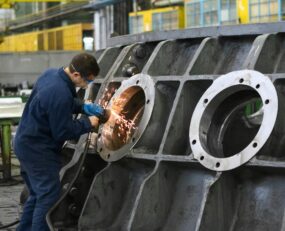
Composite PMI
In January, the Eurozone economy found itself stuck in contraction, as revealed by the S&P Global’s PMI survey. The composite PMI for the Eurozone stood at 47.9, falling short of the consensus expectation of 49 and below December’s 48.8. Although the slight increase from 47.6 to 47.9 in the composite PMI hints at a possible bottoming out, it still signifies an overall contraction as the reading remains below 50, with France and Germany experiencing declining PMIs. However, the condition of the service sector indicates an acceleration in input costs, suggesting continued economic strain.
Manufacturing PMI
While the Eurozone’s manufacturing remains in contraction at 46.6, it marks an improvement from December’s 44.4 and surpasses the consensus expectation of 44.8. Notably, Germany and France, the largest economies in the currency union, witnessed an uptick in manufacturing PMIs, offering a glimmer of hope amid economic challenges. Germany, in its 19th consecutive month of manufacturing recession, exhibited a softened downturn reflected in the steadily rising PMI index since August of the previous year. In contrast, the U.S. surpassed analyst expectations, emphasising the strength of its economy. The U.S. Manufacturing PMI rose from 47.9 in December to 50.3 in January, indicating expansion.
British services firms experienced growth, contributing to a modest recovery in the sluggish economy. However, the inflationary impact of Red Sea tensions affected struggling factories. Attacks by Yemen’s Houthis disrupted shipping, leading to a significant drop in the delivery times index in the Eurozone factory PMI, below 50 for the first time in a year. The European Union faces the risk of surging consumer prices and slowed growth due to these disruptions.
Red Sea reroutings are affecting supply chains in the manufacturing sector, evident in the sharp fall in the delivery times sub-index. Commercial vessel attacks prompted detours around the Cape of Good Hope, extending journeys by approximately seven days and incurring significant additional fuel costs. Despite these challenges, the ongoing dip in costs suggests that transport expenses may not yet wield overwhelming influence over the aggregate unit costs of consumer goods.
Overall, the Eurozone’s economic challenges persist, with the PMI survey indicating contraction in January. While manufacturing PMIs in Germany and France show signs of stabilisation, external disruptions, particularly those in the Red Sea, pose threats to supply chains and economic recovery. As the Eurozone navigates these challenges, the economy’s recovery trajectory and speed remains uncertain, requiring strategic measures to foster stability and growth, and it seems like in the long run, European manufacturing may pick up the slack if demand continues to shift away from Asian goods, even if costs remain high.